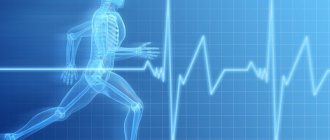All people experience feelings of anxiety and fear in different situations. A mother is worried about her sick child, a child is afraid of the neighbor’s dog, a grandmother is afraid of falling into ice, a novice motorist is afraid of getting into an accident... Why does the state of fear and increased anxiety in certain cases become the subject of study by psychiatry?
In all the examples given, there is a specific reason for anxiety and fear. Experiencing fear and anxiety in the face of real danger is the norm for a healthy person, the inclusion of protective mechanisms that help maintain health and life.
This kind of anxiety is called physiological. But if a person, as a result of the influence of mental disorders or psychological factors, including as a result of short-term intense stress or long-term mental overstrain, begins to constantly experience a feeling of fear or anxiety without any specific reason, we are talking about pathological anxiety.
You need to know that anxiety is a universal means that the human psyche uses as a warning about trouble. It may also indicate the emergence of a number and even most mental disorders. Experts speak of it as the cornerstone of psychiatry.
At the same time, when it comes to the neurotic level of anxiety, the following diagnostic names are usually used: anxiety neurosis, neurosis of fear and anxiety, generalized anxiety disorder (GAD). The latter name is given in the International Classification of Diseases (ICD-10), developed by WHO, but traditional terminology is still used in popular science literature and textbooks. Anxiety neurosis should be differentiated from phobias, since, despite the commonality - the irrational nature of fear - in phobias the object of fear itself is present. A characteristic feature of fear neurosis is to generalize an initially limited process into a widespread one, which in development has not only increasing mental, but also somatic, as well as vegetative manifestations.
Mechanism of occurrence and course of the disease
Anxiety neurosis can be fueled by some objective reasons: information about layoffs, an aggressive leadership style, difficult relationships with colleagues or relatives, emotional articles in the media or television programs. Normally, all these events occupy a person’s thoughts for a short time.
But sometimes strong emotional stress, deep-seated emotional drives (obsessive, aggressive, sexual) cause constant painful multi-day thoughts on the topics: if there is a dismissal in our country, will I be fired, how to behave if the boss is rude to me, what to do if in the country a war, famine, a coup will begin... These thoughts, which have no specific reason, completely occupy attention, are considered from all sides, a person constantly makes supposed plans and fictitious dialogues. This is how the neurosis of fear and anxiety arises and develops under the influence of psychological factors.
The cause of the disease can also be physiological factors - hormonal changes (including age-related, in pregnant women, etc.), pathologies in the endocrine system (adrenal glands, which affect hormonal levels, thyroid gland), excessive intellectual or physical stress, diseases of a general nature. Anxiety neurosis occurs in acute form, but more often it is chronic. It can arise as a consequence of an attack of sudden intense fear or develop gradually. Regardless of the mechanism of occurrence and severity, the disease worries for a long time, accompanied by a distinct feeling of internal tension and discomfort, as well as symptoms of a physiological nature.
Types of phobic neurosis
A phobia is a strong fear of some action, object or person. Sometimes just memories are enough to cause panic. As a rule, all known phobias in the world develop in two ways, namely:
- Primary reflex - fear may appear when performing some specific work if the first attempt was unsuccessful and led to negative consequences. For example, a person is afraid to make tea after getting a burn.
- Secondary reflex - fears arise, for example, during a conversation on the phone, because the last time during this there was a fire or some kind of unpleasant accident.
In the modern world, agoraphobia is very common - a case when a person is terrified of open space. As a result, he quite voluntarily stays indoors all the time and tries not to go anywhere. The opposite of phobic neurosis is claustrophobia, when a person is very afraid of closed spaces and always tries to be in the most spacious rooms or on the street.
If a person is afraid of heights, then this problem is called acrophobia and it is also classified as a phobic neuroses, which are very common. At the same time, many people may be afraid of animals - zoophobia. If a person has a panicky fear of being the center of attention, then social phobia is present. The number of phobias today is very large, but they all have one thing in common: a person has a fairly serious mental disorder and this shows all the signs of a problem.
Experts distinguish three different types in which panic fear is expressed. Each following type is considered more severe and is much more difficult to treat than the previous one:
- a person very often touches objects that have become objects of his panic fear;
- the person is constantly expecting that soon there will be a touch in the object, which became the cause of the development of the phobia;
- a person only imagines that he is touching an object of fear, and this already becomes the reason that he begins to be afraid.
Symptoms of anxiety neurosis
The clinical manifestation of the disease is characterized by the following symptoms of a mental, somatic and vegetative nature:
- causeless anxiety of varying intensity: from a state that the patient describes as “anxious in the soul” to a paroxysmal feeling of an impending catastrophe;
- persistent intrusive thoughts of disturbing content with detailed thinking about dialogues or actions in response to various imaginary events;
- anxiety or fear over the most insignificant reasons;
- increased irritability;
- panic attacks during exacerbation;
- the occurrence of concomitant mental disorders during a long chronic period of the disease - hypochondria, depression, obsessive-compulsive neurosis;
- vegetative-vascular hyperactivity, which can be expressed in pain in the heart, rapid heartbeat, respiratory distress (feeling of lack of air), discomfort in the epigastric region (between the navel and sternum), dry mouth, increased sweating;
- sleep disorders - insomnia, interrupted sleep, disturbing dreams, nightmares;
- muscle hypertonicity, inability to relax, fussiness, tension headaches, trembling due to impaired motor functions;
- feeling of constant fatigue, lightheadedness, dizziness, loss of orientation;
- nausea, stool disorder (IBS - irritable bowel syndrome), appetite.
The main symptom of generalized anxiety disorder is the patient’s inability to clearly identify the cause or object of a long-lasting (from several weeks to several months) state of fear and anxiety.
Content
- 1 Causes and mechanics of the development of neurosis
- 2 Selection criteria
- 3 Symptoms 3.1 Mental symptoms
- 3.2 Physical symptoms
- 4.1 Headache
Neurosis
,
psychoneurosis
,
neurotic disorder
(Novolat. neurosis from ancient Greek νεῦρον “nerve”) is an outdated name for a group of neuropsychic disorders that arise due to acute and chronic psychological trauma and are characterized by the absence of qualitative changes in mental activity [1]. The clinical picture of such disorders is characterized by asthenic, obsessive or hysterical manifestations, as well as a temporary decrease in mental and physical performance [2].
The psychogenic factor in all cases is conflicts (external or internal), the action of circumstances causing psychological trauma, stress or prolonged overstrain of the emotional and intellectual spheres of the psyche [2].
The concept of “neurosis” was introduced into medicine in 1776 by Scottish physician William Cullen. The content of the term has been revised several times; the term still does not have an unambiguous generally accepted definition. It should also be borne in mind that in medicine and biology, “neurosis” can be called various functional disorders of higher nervous activity.
Mental disorders have traditionally been differentiated into neuroses and psychoses. Unlike psychotic disorders, with neuroses people are critical of their disorder and are able to control their actions [1].
The term "neurosis" is no longer used by the professional psychiatric community in the United States of America[3]. In the American Diagnostic and Statistical Manual of Mental Disorders, the section on “neuroses” was abolished from the third edition of DSM-III in 1980. For example, depressive neurosis was replaced by dysthymic disorder, obsessive-compulsive neurosis by obsessive-compulsive disorder, hypochondriacal neurosis by hypochondria, etc.[4]. Since the tenth revision of the International Classification of Diseases (ICD-10), the traditional differentiation between neuroses and psychoses is also no longer applied. However, the term “neurotic” is used in the title of the section (group) of mental disorders “Neurotic, stress-related, and somatoform disorders” (s 40.-48.)[5].
Treatment of anxiety neurosis in
Specialists from the Neopsy Center for Mental Health (Moscow) can cure fear and anxiety neurosis using modern methods of psychotherapy and drug treatment based on evidence-based medicine. At the first consultation with a psychotherapist or psychiatrist, not only the patient, but also his relatives can be present. This will help collect a more complete and reliable history about the patient’s lifestyle, the onset and course of the disease, past illnesses and stress.
If there are symptoms of a somatic and vegetative nature, measures will be prescribed to differentiate anxiety neurosis from other diseases, signs of which these manifestations may be. In such cases, consultations with a cardiologist, endocrinologist, laboratory and instrumental examinations are prescribed. Timely treatment at the initial stage of the disease can be limited to psychotherapeutic influence, which is what the Center’s specialists usually strive for.
When developing a treatment plan, all the features of the patient’s physiology and psyche and the course of anxiety neurosis are taken into account. Taking into account these features, the method of psychotherapeutic influence is selected:
- individual existential, analytical and cognitive behavioral psychotherapy;
- hypnotherapy;
- autogenic training;
- training in breathing exercises and relaxation techniques.
Physiotherapy may be prescribed, including exercise therapy and relaxation massage. In the active stage of the disease, drug therapy is extremely useful, which may include the prescription of antidepressants and tranquilizers. Drugs, dosages and dosage regimens are prescribed strictly individually.
At the Center, an individual approach is a mandatory rule of work for our specialists in the treatment of any pathology, including anxiety neurosis. The experience of the Center’s constantly practicing specialists proves that the prognosis for the treatment of anxiety neurosis is favorable: if the disease is treated at an early stage of its occurrence, more than 90% of patients are cured without the danger of relapse. Timely treatment is the key to a lasting therapeutic effect! Sign up for a consultation through the website services (feedback, make an appointment) or call the specified phone number.
Symptoms[ | ]
| This section is missing references to information sources. Information must be verifiable, otherwise it may be questioned and deleted. You may edit this article to include links to authoritative sources. This mark was set on May 10, 2013 . |
Mental symptoms[ | ]
- Emotional distress (often for no apparent reason).
- Indecisiveness.
- Communication problems.
- Inadequate self-esteem: underestimation or overestimation.
- Frequent experiences of anxiety, fear, “anxious expectation of something,” phobias, possible panic attacks, panic disorder.
- Uncertainty or inconsistency of the system of values, life desires and preferences, ideas about oneself, about others and about life. Cynicism is common.
- Instability of mood, its frequent and sharp variability.
- Irritability (see more details: neurasthenia).
- High sensitivity to stress - people react to a minor stressful event with despair or aggression.
- Tearfulness.
- Touchiness, vulnerability.
- Anxiety.
- Preoccupation with a traumatic situation.
- When trying to work, they quickly get tired - memory, attention, and thinking abilities decrease.
- Sensitivity to loud sounds, bright light, temperature changes.
- Sleep disorders: it is often difficult for a person to fall asleep due to overexcitation; superficial, disturbing sleep that does not bring relief; Drowsiness is often observed in the morning.
Physical symptoms[ | ]
- Headaches, heart pain, abdominal pain.
- A frequently manifested feeling of fatigue, increased fatigue, a general decrease in performance (see more details: neurasthenia).
- Panic attacks, dizziness and darkening of the eyes from pressure changes.
- Vestibular disorders: difficulty maintaining balance, dizziness.
- Appetite disturbances (overeating; undereating; feeling hungry, but quickly feeling full when eating).
- Sleep disorders (insomnia): difficulty falling asleep, early awakening, awakenings at night, lack of feeling of rest after sleep, nightmares.
- Psychological experience of physical pain (psychalgia), excessive concern for one’s health up to hypochondria.
- Autonomic disorders: sweating, palpitations, fluctuations in blood pressure, disruption of the stomach, cough, frequent urge to urinate, loose stools.
- Sometimes - decreased libido and potency.
- Speech defects (stuttering).
The connection between neuroses and other diseases and symptoms[ | ]
| This section is not completed. You will help the project by correcting and expanding it. |
Headache[ | ]
| This section is not completed. You will help the project by correcting and expanding it. |
Main article: Headache
Headache occurs in various mental conditions and diseases. It usually occurs in case of emotional overstrain or in case of suppression of one's feelings, for example, feelings of anger. The headache can also be hallucinatory (psychalgia).
Vegetovascular dystonia[ | ]
Main article: Vegetovascular dystonia
| This article or section needs revision. Please improve the article in accordance with the rules for writing articles. |
Vegetovascular dystonia is a disorder of the autonomic nervous system. Unlike the somatic nervous system, which obeys the mind and controls the muscles, the autonomic nervous system works automatically and ensures the functioning of the organs and systems of the body. The autonomic nervous system is divided into sympathetic and parasympathetic; they act in many ways opposite to each other and are responsible for different functions in the body. Together, they complement each other’s functions and form a complex system. This system is associated with areas of the brain responsible for our emotions, behavior, and hormonal regulation of the body. Therefore, in various mental disorders, when the emotional background changes, the activity of the autonomic nervous system inevitably changes, which begins to work incorrectly - either overly active (increased heart rate, blood pressure, respiratory rate, intestinal motility), or, on the contrary, inhibited. In a situation of danger, the autonomic nervous system mobilizes the body's forces, increases blood pressure, etc., in order to cope with danger. If a person often cannot actively respond to what he considers dangerous (for example, due to social factors) and is forced to suppress his arousal, and also if many situations that are not dangerous cause him a feeling of fear (or if he suffers from panic attacks), then the autonomic nervous system begins to malfunction, errors accumulate and its imbalance occurs, which leads, in addition to the immediate symptoms of VSD, to disruptions in the functioning of various organs [ source not specified 1389 days
].
Panic disorders, phobias, anxiety[ | ]
| This section of the article has not been written. According to the plan of one or more Wikipedia contributors, a special section should be located in this place. You can help by writing this section. This mark was set on December 31, 2020 . |
Main article: Panic disorder
Main article: Phobia
Main article: Anxiety disorder
Various anxiety disorders (panic attacks, phobias, constant background feelings of anxiety) quite often accompany neurosis.










